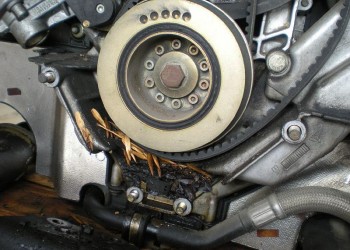The alternator is a key component of the electrical system of your car. It converts the mechanical energy from the rotating engine to electricity, which is then used to charge the battery and power the numerous systems in the vehicle that requires electricity to function.
Warning Signs of a Failing Alternator
When your alternator fails, most likely due to age, your vehicle will be grounded. Like most modern luxury vehicles, your Range Rover and LR3 depend on a complex system of computers, electrical parts, and connections to function. Fortunately, a failing alternator will give you some signs before parking up.
Here are some of the signs to watch out for and act immediately, so you don’t get stranded.
- - Intermittent flashing of Dashboard Warning Lights: one of the earliest signs of failing alternator in your Range Rover is the intermittent flashing of the low-battery dashboard warning light. The warning lights on your dashboard indicates when something is wrong with any of the numerous systems of the car. Usually, the warning lights use symbols and acronyms to indicate what particular part is having a problem. But if you don’t understand what any of the warning light means, consult your owners manual. A flashing low-battery sign requires urgent attention because the car battery drains rather quickly once the alternator malfunctions.
- - Dimming Headlights: since the alternator powers the car’s electrical systems, weak headlights is another common sign that it’s failing. Additionally, other accessories powered by electricity such as sound systems, power windows and locks, and the instrument cluster may not work properly or stop working altogether.
- - Dead Car Battery: the car battery will end up dying when the alternator stops to work. While a failing alternator is not the only reason for a dead battery, always check the alternator when replacing a dead car battery. The new battery will drain quickly just like the old one if the alternator is faulty.
- Noisy Cooling fans: a sudden increase in the noise from the cooling fans is another sign of a failing alternator. What happens here is that a faulty diode in the alternator will induce an AC current in the body control module which then interprets it as a signal to energize the fans further.
Replacing a faulty alternator will set you back about $200 for labor at the dealership. Or you can buy the part yourself and replace it in your garage.
Tools you’ll need.
3/8 Ratchet, 13mm wrench, 10mm wrench, Long Extended Bar with a 15mm socket
Procedure
Here’s a step by step procedure you can follow:
- 1. Disconnect the negative lead of the battery. Pull the two tabs holding the plastic cover and pull it off. Use a 13mm wrench or a plier to loosen the bolt on the negative lead. It’s the one closest to the back of the vehicle.
- 2. Raise the vehicle on jack stands.
- 3. Remove the steel splash pan. Get underneath the vehicle and locate the steel splash pan. It’s held by Ten 10mm bolts. Loosen the bolts and lower the splash pan to the floor. Pop out the two side plastic strips to gain access to the alternator.
- 4. Remove the front plate. It’s being held by two 10mm bolts. This will give you more space to work.
- 5. Remove tension from the alternator belt. Locate the tensioner assembly. There is a cut out on it that is used to move the tensioner and which fits a 3/8 ratchet extension socket. Attach the long bar to the cutout and push inwards to release tension from the belt.
- 6. Slip the belt off the alternator. With the tension off the belt, slip it off the alternator. You don’t have to remove it totally. Leave it to the side so you can easily slip it back on when you install the new alternator.
- 7. Remove the alternator. It is held with 3 bolts which you can loosen with the 3/8 ratchet. Drop the alternator and wiggle it out of the enclosure. Disconnect the wires at the back of the alternator, You’ve got a three-wire connector - those are the field cable, ground cable, and sensor cable. Squeeze the tab to release it from the back of the alternator to get enough slack to pull the alternator forward and reach the nut that holds the main cable. Use a 13mm wrench to remove the nut and then the cable. The alternator is now completely disconnected from the vehicle. Slide it out.
- 8. Install the new alternator. Wiggle in the new alternator through the opening. Now reverse the process and put the main cable back. There are two long tabs that come 90 degrees off the flank, and they have to line up with slots that are in the alternator. Make sure they are lined up with that and partially in before you tighten up the nut so as not to cause some damage. Plug the three-wire connector into the back and make sure you push it in till you hear a distinct click which shows it is locked in place.
- 9. Bolt the alternator into place. First, line up the bottom bolts, then use them to align the top bolt. Then tighten them down.
- 10. Replace the belt. Do a quick check to ensure that the belt is on all the pulleys that it’s supposed to be on. Take the tension off the belt using the bar on the tensioner assembly as before. Then slip the belt on to the new alternator.
- 11. Drop the vehicle. Start up the engine and ensure everything is working. Check to see if the alternator is charging the battery.
- 12. Raise the vehicle again.
- 13. Replace the plastic side cover, the front panel, and the flash pan.
There you have it, the new alternator is in place, and your car will run normally now. The intermittent battery warning lights, dimming headlights, and loud fan noises should have disappeared.
Although they have similar engines, alternator replacement on the LR3 is easier than on the Range Rover Supercharged because the Range Rover has some more plumbing that gets in your way.






0 comments